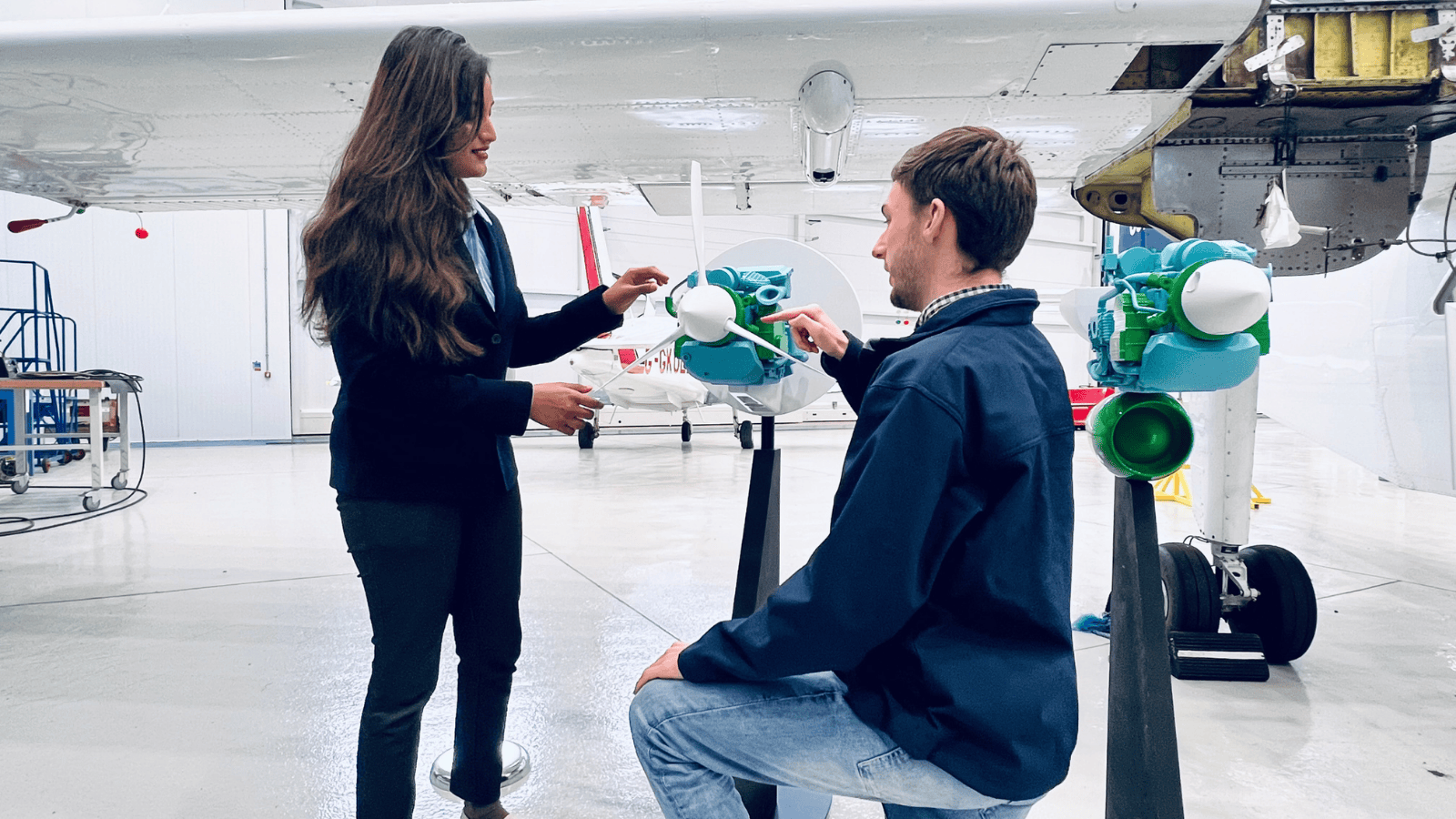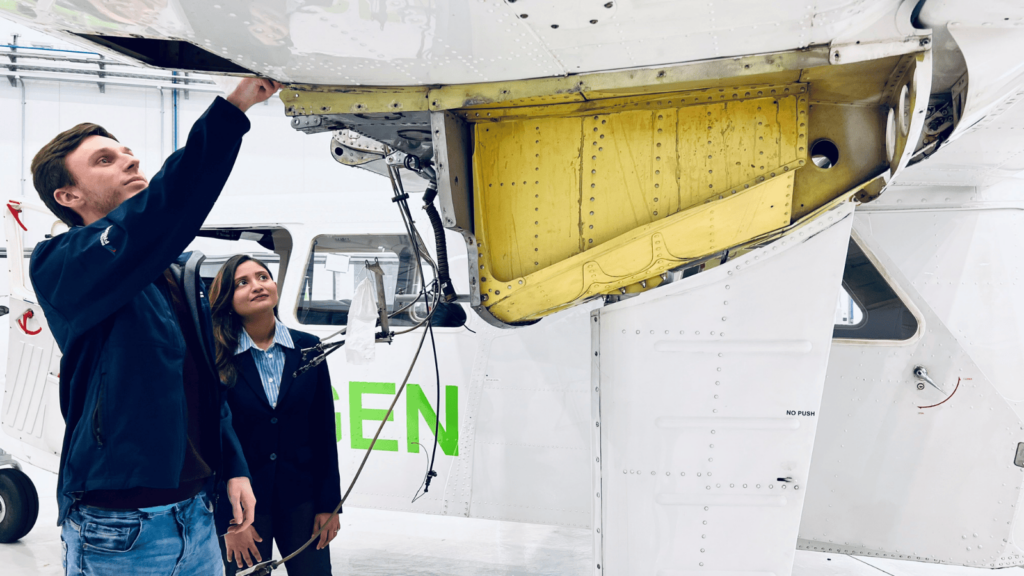In celebration of Tomorrow’s Engineers Week, we’re spotlighting two of our graduate engineers, Saai and Tom, who are making strides at Cranfield Aerospace Solutions (CAeS). Their unique journeys reveal not only how they found their way into aerospace but also what it’s like to work at the forefront of sustainable aviation. Through their experiences, we get a glimpse into the innovative environment at CAeS, the future of sustainable aviation, and advice for those aspiring to become the next generation of aerospace engineers.
The Journey to CAeS: Finding a Path in Aerospace
Saai’s Pathway: Inspired by Visionaries and a Passion for Flight
From a young age, Saai was captivated by the thrill of flight, inspired by leaders like Dr APJ Abdul Kalam, India’s former president and an aerospace visionary, and by pioneers such as Valentina Tereshkova, the first woman in space. After completing her undergraduate degree in Aeronautical Engineering in India, she sought deeper expertise in propulsion, eventually earning her postgraduate in Thermal Power and Propulsion from Cranfield University.
Saai’s path to CAeS came naturally, as her goals aligned with the company’s mission to deliver zero-emissions aircraft. Joining the Air Vehicle Design team as a Graduate Thermal Systems Engineer, Saai is now deeply involved in Project Fresson, a project dedicated to converting a B-N Islander aircraft to hydrogen propulsion. “Joining CAeS felt like a perfect fit,” she reflects, “allowing me to directly contribute to the next generation of sustainable aviation.”
Tom’s Pathway: From Childhood Curiosity to Engineering Reality
Tom’s love for aviation began during family outings to museums like Duxford, where he first marvelled at aircraft. This early fascination grew through studies in maths, physics, and chemistry, leading him to a degree in Aeronautics and Astronautics from the University of Southampton. A pivotal moment came when he attended the Engineering Design Show and connected with CAeS leadership. Shortly after, he joined as a Graduate Stress Engineer, driven by a vision of making aviation safer and more sustainable.

A Day in the Life of CAeS Engineers: Working on Tomorrow’s Aircraft
At CAeS, Saai and Tom’s roles allow them to tackle the complexities of transitioning to zero-emissions aviation. Saai spends her days performing thermal analysis and propulsion modelling, ensuring effective thermal management and energy efficiency in hydrogen-powered systems. Her favourite project has been the analysis of a hydrogen fuel distribution system for Project Fresson. “Each day brings a new challenge,” Saai says, “but it’s thrilling to know that my work is paving the way for cleaner, sustainable aviation.”
Meanwhile, Tom’s work focuses on structural analysis, ensuring that aircraft components meet rigorous safety and airworthiness standards. From Project Fresson to other initiatives, he assesses load-bearing structures to ensure they can withstand operational demands. A highlight of his time at CAeS has been working with the historic Spitfires and Hurricanes as part of a project for the Battle of Britain Memorial Flight – a unique experience that connected his childhood fascination with aircraft to his professional work.

The Road Ahead: Engineering the Future of Sustainable Aviation
Looking forward, Saai and Tom both envision a decade of rapid progress in sustainable aviation, spurred by innovation in fuel sources, hybrid-electric propulsion systems, and certification processes.
Saai hopes to advance to a senior engineering role where she can lead advancements in hydrogen fuel cells and thermal management, technologies critical to zero-emissions aviation. “Hydrogen fuel cells excite me,” she shares, “because they have the potential to completely transform how we power aircraft, reducing aviation’s environmental footprint.”
Tom, too, looks forward to a career of continued learning and growth at CAeS. His focus is on structural engineering that supports the safety and certifiability of zero-emissions aircraft. He’s particularly excited about how new materials like composites and advanced manufacturing techniques will allow engineers to achieve lighter, more efficient designs, vital to creating sustainable and certifiable aircraft.

Advice for Aspiring Engineers: Building a Future in Aerospace
For students and recent graduates interested in aerospace, both Saai and Tom offer invaluable advice:
Saai encourages students to engage with professional networks like the Royal Aeronautical Society. “Your network is your net worth,” she says, emphasising that connecting with industry professionals can open doors to opportunities and support. She also advises engineers to embrace interdisciplinary learning, noting, “In aerospace, every component is part of a bigger picture. Understanding how fields like structures, propulsion, and aerodynamics interact can elevate your approach to engineering challenges.”
Tom echoes Saai’s emphasis on finding a passion within the field. “Aerospace is so broad, you can find your niche,” he advises. He stresses the value of pursuing an area you genuinely enjoy, whether that’s aircraft, spacecraft, or other advanced systems. “If you’re passionate, the work becomes rewarding, and that passion drives your success.”

A Future of Innovation at Cranfield Aerospace Solutions
Looking ahead, CAeS aims to achieve certification for its retrofit hydrogen-powered aircraft, becoming the first to offer a certified zero-emissions passenger aircraft. It also seeks to adapt its technology to different aircraft platforms, and design clean sheet zero-emissions aircraft.
The Air Vehicle Design team will continue developing cutting-edge hydrogen propulsion systems, while the Airworthiness and Certification teams will work to secure regulatory approval for novel zero-emissions designs. Our structural & mechanical design experts are pushing the limits of material science and engineering to create lighter, safer, and more efficient aircraft.
Saai and Tom’s journeys are just beginning, but their work is already helping to pave the way for the future of aviation. Their insights, aspirations, and passion for sustainable engineering reflect the spirit of CAeS: innovating to transform aviation for a cleaner, more sustainable world.



